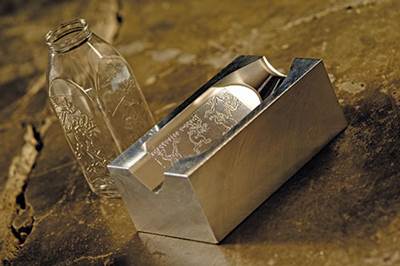Preventive Maintenance Makes Good Dollars and Sense
By keeping up with your recommended preventive maintenance (PM) schedule, you can reduce your chances of having a catastrophic breakdown.
Imagine you’re a mold manufacturer that was one of many hit hard by the Great Recession. (You may be thinking “who’s pretending?”) For the past few years, jobs have been scarce, and it was all you could do to keep your shop afloat. You’ve even considered laying off your highest paid machinists, who of course happen to be your best and most efficient. Words like “bankruptcy” and “foreclosure” swirl around in your mind. You start to lose faith that the economic state of our country will ever improve.
Then, out of the blue, you’re contracted for the largest job you’ve had in years. This big budget job is a big break for your shop. As with many contract jobs, this one comes with a tight deadline. Even though you’re now working under lean operations conditions, you’re in no financial position to negotiate more time and risk losing this opportunity,¬ so you get to work right away. You set up the workholding and program the machine. Suddenly, the dreaded flow alarm can be heard across your shop. You run over to see what’s going on, and you find that you have a clogged filter—a break you did not anticipate.
Immediately you call your local service provider, but since they too are working under lean operations they don’t have a service technician available to come out until the next business day. There’s nothing you can do but wait. Every passing minute is costing you money. You’re now paying your operator to do nothing, and perhaps more importantly, you’re losing time.
This hypothetical scenario can end in two ways: (1) either you lose the contract, or (2) your service provider comes to the rescue and saves the day. Whether it’s the contract you’ve compromised or the stress you’ve endured, these challenges could have been avoided. By keeping up with your recommended preventive maintenance (PM) schedule, you can reduce your chances of having a catastrophic breakdown.
Reactive Maintenance Costs
The idea of stopping production on your machine for the small amount of time it takes to perform regularly scheduled maintenance—and the costs involved—might make you cringe. However, studies show that reactive maintenance programs on average cost 12 to 18% more than preventive maintenance programs.
Preventive maintenance also gives you the flexibility to choose when your machine will be shut down, perhaps during holiday breaks when productivity is already reduced.
Preventive Maintenance Controls Potential Costs
When you look at the overall cost of maintenance in your business, you’ll soon realize this can be a sizable budget item. So the overall goal and benefit of planning maintenance proactively through a preventive maintenance program is to reduce these costs and maximize productivity.
A good preventive maintenance program for your CNC machine includes a system of cleaning, checking and replacing various components on a regular schedule. There are many preventive maintenance activities that should be performed by shop employees on a daily basis, while other more extensive operations are carried out over longer time frames by a certified service engineer, which are typically available through your service provider or distributor.
Following are some general guidelines to effective preventive machine tool maintenance. Note: check with your machine tool builder to learn their specific recommendations.
Daily Preventive Maintenance Activities
• Check hydraulic pressure, hydraulic fluids, chuck pressure, lube levels; and, if you have a cooling system, check the cooling unit level
• Clean out chips, grease parts as needed, clean off windows and doors, and wipe down and lubricate way covers so they move smoothly
Every Three Months or 500 Hours
• Check and grease the chain on the chip conveyor
• Check and clean the filters on the coolant tank
Every Six Months or 1,000 Hours
Have the following preventive maintenance performed by a certified engineer:
• Clean the coolant tank of sludge, chips and oil
• Clean the chuck and jaws
• Drain the hydraulic tank and replace the hydraulic oil, and change the line filter and suction filter
• Clean the radiator and make sure the radiator fins are straight
• Drain and clean the lubrication unit and add fresh way lube
• Drain and refill the cooling unit
• Check the leveling of your machine and adjust if necessary
• Clean and inspect way wipers and replace any wipers that are damaged
Once a Year or Every 2,000 Hours
Have your certified engineer perform the following inspections:
• Check the headstock for taper
• Check the spindle for radial and end play
• Check the chuck cylinder for run out
• Check the tailstock for taper
• Check turret parallelism and inclination
• Run a backlash program to check the backlash in X and Z axis
• Check the X and Z axis gibs
Three Simple Take-Action Tips
There are ways you can take action with a planned preventive maintenance program while minimizing disruptions to your workflow and productivity. Consider the following:
1. Schedule preventive maintenance during known shutdown times, such as holiday breaks. During a known shutdown period, productivity is already reduced.
2. Order your preventive maintenance kit early. This minimizes variables in leadtime and ensures you can take advantage of that opportune window of time during a scheduled shutdown.
3. During a preventive maintenance service, inspect your machine for unseen or potential issues. When you’ve slid back the covers on your machine, you may see areas of wear that couldn’t be detected on a daily basis, and this gives you a chance to make repairs before an expensive failure occurs.
Summary
Preventive maintenance is about more than just protecting your CNC machine investment. By having a proactive preventive maintenance plan in place, you’re ensuring you can maximize your productivity too. Here we’ve presented some general guidelines to follow, and if this inspires you to embark on some thorough preventive maintenance planning, you’ll begin to keep those dollars flowing into your business, and that just makes good sense.
Related Content
How to Eliminate Chatter
Here are techniques commonly used to combat chatter and guidelines to establish a foundation for optimizing the moldmaking process.
Read MoreMachining Center Spindles: What You Need to Know
Why and how to research spindle technology before purchasing a machining center.
Read MoreThree Good Reasons to Switch from Three- to Five-Axis Machining in Moldmaking
Five-axis machining technology is a great tool in the moldmaker toolbox.
Read MoreRead Next
Enhance Mold Precision by Going Five-Axis
Here’s how to manufacture large or high-precision, complex molds while maintaining efficiency.
Read MoreAre You a Moldmaker Considering 3D Printing? Consider the 3D Printing Workshop at NPE2024
Presentations will cover 3D printing for mold tooling, material innovation, product development, bridge production and full-scale, high-volume additive manufacturing.
Read MoreHow to Use Continuing Education to Remain Competitive in Moldmaking
Continued training helps moldmakers make tooling decisions and properly use the latest cutting tool to efficiently machine high-quality molds.
Read More





















